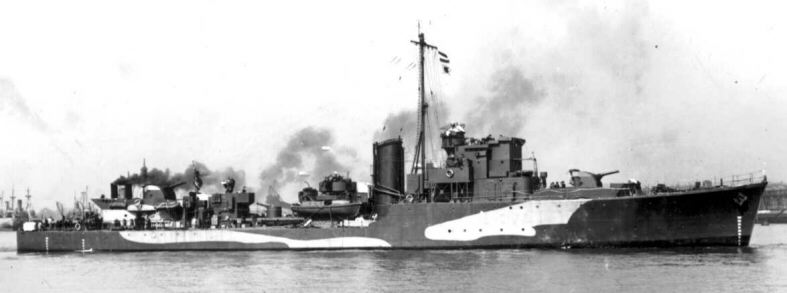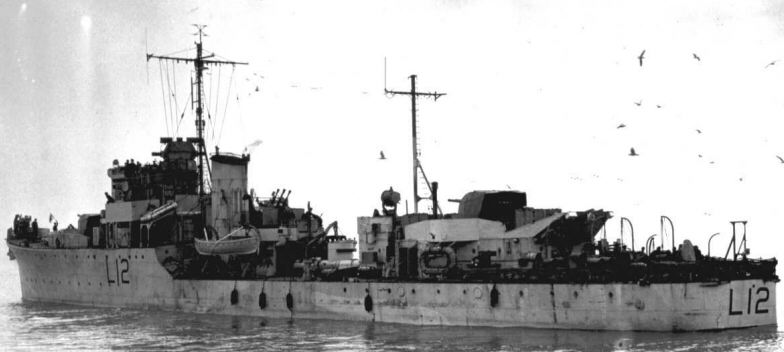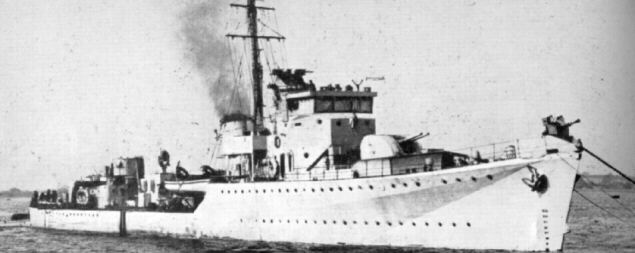| . |
|
|
|
|
| Name |
Pennant |
Builder |
Completed |
Fate |
| Group 1 |
| Atherstone |
L05 |
Cammell Laird |
23/3/40 |
Scrapped 1957 |
| Berkeley |
L17 |
Cammell Laird |
6/6/40 |
Bombed by
German planes, August 1942 |
| Cattistock |
L35 |
Yarrow |
22/7/40 |
Scrapped 1957 |
| Cleveland |
L46 |
Yarrow |
18/9/40 |
Sold 1957 for
scrapping, wrecked on Rhossili Sands 28/6/57 & blown
up 14/12/59 |
| Cotswold |
L54 |
Yarrow |
16/11/40 |
Scrapped 1987 |
| Cottesmore |
L78 |
Yarrow |
29/12/40 |
To Egypt 1950
as Ibraham-El-Awal, then 1951 Mohamed-Ali-El-Khebir.
Captured by Israel 31/10/56, and renamed Haifa,
scrapped 1972 |
| Eglinton |
L87 |
Vickers |
28/8/40 |
Scrapped 1956 |
| Exmoor |
L61 |
Vickers |
1/11/40 |
Torpedoed by
E-boat, February 1941 |
| Fernie |
L11 |
J. Brown |
29/5/40 |
Scrapped 1956 |
| Garth |
L20 |
J. Brown |
1/7/40 |
Scrapped 1958 |
| Hambledon |
L37 |
Swan Hunter |
8/6/40 |
Scrapped 1958 |
| Holderness |
L48 |
Swan Hunter |
10/8/40 |
Scrapped 1956 |
| Mendip |
L60 |
Swan Hunter |
12/10/40 |
To China 1947
as Lin Fu, Egypt 1949 as Mohamed-Ali-el-Khebir,
then
Ibrahim-El-Awal, then 1951 Port Said |
| Meynell |
L82 |
Swan Hunter |
30/12/40 |
To Equador
1954 as Presidente Velasco Ibarra, stricken 1978 |
| Pytchley |
L92 |
Scotts |
23/10/40 |
Scrapped 1956 |
| Quantock |
L58 |
Scotts |
6/2/41 |
To Equador
1954 as Presidente Alfaro, stricken 1978 |
| Quorn |
L66 |
Whites |
21/9/40 |
Lost in
colission with MTB off Normandy, October 1944 |
| Southdown |
L25 |
Whites |
8/11/40 |
Scrapped 1956 |
| Tynedale |
L96 |
Stephens |
2/12/40 |
Torpedoed by
U-593, December 1941 |
| Whaddon |
L45 |
Stephens |
28/2/41 |
Scrapped 1959 |
| Group 2 |
| Avon
Vale |
L06 |
J.
Brown |
17/2/41 |
To
Greece 1944 as Aegion, returned 1944. Scrapped
1958 |
| Blencathra |
L24 |
Cammell
Laird |
14/12/40 |
Scrapped
1959 |
| Brocklesby |
L42 |
Cammell
Laird |
9/4/41 |
Scrapped
1957 |
| Liddesdale |
L100 |
Vickers |
3/3/41 |
Scrapped
1948 |
| Badsworth |
L03 |
Cammell
Laird |
18/8/41 |
To
Norway 1944 as Arendal, scrapped 1961 |
| Beaufort |
L14 |
Cammell
Laird |
3/11/41 |
To
Norway 1952 as Haugesund, scrapped 1965 |
| Bedale |
L26 |
Hawthorn
Leslie |
9/5/42 |
To
Poland 1942 as Slazak. Returned 1945, to India
as Godavari. Scrapped 1979 |
| Bicester |
L34 |
Hawthorn
Leslie |
18/6/42 |
Scrapped
1958 |
| Blackmore |
L43 |
Stephens |
14/4/42 |
To
Denmark 1952 as Esben Snare, scrapped 1966 |
| Blankney |
L30 |
J.
Brown |
11/4/41 |
Scrapped
1959 |
| Branham |
L51 |
Stephens |
16/6/42 |
To
Greece 1943 as Themistolkes, scrapped 1960 |
| Burton |
L08 |
Swan
Hunter |
18/10/41 |
Renamed
Exmoor 1941, to Denmark as Valdemar Sejr 1952.
Scrapped 1966 |
| Calpe |
L71 |
Swan
Hunter |
11/12/41 |
To
Denmark 1952 as Rolf Krake, scrapped 1966 |
| Chiddingfold |
L31 |
Scotts |
16/10/41 |
To
India 1953 as Ganga, scrapped 1975 |
| Cowdray |
L52 |
Scotts |
29/7/42 |
Bombed
by Germany off Algiers 8/11/42 & beached. Salved
16/11/42, scrapped 1959 |
| Croome |
L62 |
Scotts
|
29/6/41 |
Scrapped
1957 |
| Dulverton |
L63 |
Stephens |
27/9/41 |
Bombed
by Germany off Leros, 13/11/43 |
| Eridge |
L68 |
Swan
Hunter |
28/2/41 |
Torpedoed
by E-boat in Mediterannean 29/8/42 & written off as
accomodation
hulk. Scrapped 1946 |
| Farndale |
L70 |
Swan
Hunter |
27/4/41 |
Scrapped
1962 |
| Grove |
L77 |
Swan
Hunter |
5/2/42 |
Torpedoed
by U-boat U.77 off Sollum 12/6/42 |
| Heythorp |
L85 |
Swan
Hunter |
21/6/41 |
Torpedoed
by U-boat U.625 off Sollum 20/3/42 & sunk by
gunfire of HMS Eridge |
| Hursley |
L84 |
Swan
Hunter |
2/4/42 |
To
Greece 1943 as Kriti, scrapped 1960 |
| Hurworth |
L28 |
Vickers |
5/10/41 |
Mined
off Kalymos, 20/10/43 |
| Lamerton |
L88 |
Swan
Hunter |
16/8/41 |
To
India as 1953 Gomati, scrapped 1975 |
| Lauderdale |
L95 |
Thornycroft |
24/12/41 |
To
Greece 1946 as Aigaion, scrapped 1960 |
| Ledbury |
L90 |
Thornycroft |
11/2/42 |
Scrapped
1959 |
| Middelton |
L74 |
Vickers |
10/1/42 |
Scrapped
1957 |
| Oakley |
L72 |
Vickers |
17/6/41 |
To
Poland 1942 as Kujawiak, mined off Valetta
16/6/42 & foundered in tow |
| Puckeridge |
L108 |
Whites |
30/4/41 |
Torpedoed
by U-boat U.617 off Gibraltar 6/9/43 |
| Silverton |
L115 |
Whites |
28/5/41 |
To
Poland 1941 as Krakowiak, returned 1946.
Scrapped 1959 |
| Southwold |
L10 |
Whites
|
9/10/41 |
Mined
off Valetta 24/3/42 & foundered in tow |
| Tetcott |
L99 |
Whites |
11/12/41 |
Scrapped
1956 |
| Tickham |
L98 |
Yarrow |
7/5/42 |
Renamed
Oakley 1941. To West Germany 1958 as Gniesenau.
Scrapped 1977 |
| Wheatland |
L122 |
Yarrow |
3/11/41 |
Scrapped
1957 |
| Wilton |
L128 |
Yarrow |
18/2/42 |
Scrapped
1959 |
| Zetland |
L59 |
Yarrow |
27/6/42 |
To
Norway 1952 as Tromso, scrapped 1965 |
| Group 3 |
| Airedale |
L07 |
J.
Brown |
8/1/42 |
Bombed
by Germany off Crete 15/6/42 & torpedoed by HMS Aldenham |
| Albrighton |
L12 |
J.
Brown |
22/2/42 |
To
West Germany 1957 as Raule, scrapped 1969 |
| Aldenham |
L22 |
Cammell
Laird |
5/2/42 |
Mined
off Pola 14/12/44 |
| Belvoir |
L32 |
Cammell
Laird |
29/3/42 |
Scrapped
1947 |
| Blean |
L47 |
Hawthorn
Leslie |
23/8/42 |
Torpedoed
by U-boat U.443 off Oran 11/12/42 |
| Bleasdale |
L50 |
Vickers |
16/4/42 |
Scrapped
1956 |
| Bolebroke |
L65 |
Swan
Hunter |
27/6/42 |
To
Greece 1942 Pindos, scrapped 1960 |
| Border |
L67 |
Swan
Hunter |
5/8/42 |
To
Greece 1942 Adrias. Mined off Kalymnos 22/10/42
& repaired. Scrapped 1945 |
| Catterick |
L81 |
Vickers |
12/6/42 |
To
Greece 1946 Hastings, Scrapped 1963 |
| Derwent |
L83 |
Vickers |
24/4/42 |
Scrapped
1946 |
| Easton |
L09 |
Whites
|
7/12/42 |
Scrapped
1952 |
| Eggesford |
L15 |
Whites |
21/4/43 |
To
West Germany 1959 as Brommy, scrapped 1979 |
| Eskdale |
L36 |
Cammell
Laird |
31/7/42 |
To
Norway 1942. Tropedoe by E-boats S.65, S.90
& S.112 off The Lizard 14/4/43 |
| Glaisdale |
L44 |
Cammell
Laird |
12/6/42 |
To
Norway 1942. Renamed Narvik 1946. Scrapped 1961 |
| Goathland |
L27 |
Fairfield |
6/11/42 |
Mined
off Normandy beaches 24/7/44 & written off. Scrapped
1945 |
| Haldon |
L19 |
Fairfield |
30/12/42 |
To
To France 1942 as La Combattante. Mined off East
Dudgeon Bouy 23/2/45 |
| Hatherleigh |
L53 |
Vickers |
10/8/42 |
To
Greece 1942 as Kanaris, scrapped 1960 |
| Haydon |
L75 |
Vickers |
24/10/42 |
Scrapped
1958 |
| Holcombe |
L56 |
Stephens
|
16/9/42 |
Torpedoed
by U-boat U.593 off Bougie 12/12/43 |
| Limborne |
L57 |
Stephens |
24/10/42 |
Torpedoed
by German torpedo boats T.22 & T.24
off Channel Islands 23/10/43.
Torpedoed by HMS Rocket and Talybont |
| Melbreak |
L73 |
Swan
Hunter |
10/10/42 |
Scrapped
1956 |
| Modbury |
L91 |
Swan
Hunter |
25/11/42 |
To
Greece 1942 as Miaoulis, scrapped 1961 |
| Penylan |
L89 |
Vickers |
31/8/42 |
Torpedoed
by E-boat S.115 off Start Point, 3/12/42 |
| Rockwood |
L39 |
Vickers |
4/11/42 |
Bombed
by Germany in Aegean Sea 11/11/43 & written off.
Scrapped 1946 |
| Stevenstone |
L16 |
Whites |
18/3/43 |
Scrapped
1959 |
| Talybont |
L18 |
Whites |
19/5/43 |
Scrapped
1961 |
| Tanatside |
L69 |
Yarrow
|
4/9/42 |
To
Greece 1946 as Adrias, scrapped 1964 |
| Wensleydale |
L86 |
Yarrow |
30/10/42 |
Collided
with LST.367 in English Channel 21/11/44.
Written off & scrapped 1947 |
| Group 4 |
| Brecon |
L76 |
Thornycroft
|
18/12/42 |
Scrapped
1962 |
| Brissenden |
L79 |
Thornycroft |
12/2/43 |
Scrapped
1965 |
| |
 |
1:600 Hunt class, group 1,
with the 2pdr. bow-chaser and single 20mm AA in the
wings. ©
Andrew Arthur |
 |
| 1:600 Hunt class group 1,
HMS Eglington. © Andrew Arthur |
 |
1:600 Hunt class, group 2,
with the modified bridge, third twin 4" and the quad
pom-pom moved
amidships © Andrew Arthur |
 |
| 1:600 Hunt class group 2,
HMS Badsworth. © Andrew Arthur |
 |
| 1:600 Hunt class group 2,
HMS Chiddingford. © Andrew Arthur |
 |
1:600 Hunt class, group 3.
The bridge was modified and moved aft, the mast and
funnel had no
rake, the quarterdeck gun removed, the searchlight moved
onto the aft shelter deck, a twin 21"
torpedo tube amidships and a third 20mm AA on the aft
shelter deck. Although little heavier than
the group 2, the shift in weight distribution needed 40
tons of permanent ballast to maintain stability
© Andrew Arthur |
 |
| 1:600 Hunt class group 2,
HMS Aldenham, in a striking splinter camouflage
© Andrew Arthur |
 |
| 1:600 Hunt class group 3,
HMS Wensleydale © Andrew Arthur |
 |
1:600 Hunt class group 4,
HMS Brecon. They were largely different to the
other class members,
with a new hull, armament and superstructure, but with a
common powerplant and role - albeit much
more capable and expensive. They lacked the stabilisation
tanks, being large enough to be inherintly
stable. © Andrew Arthur |
 |
1:600 Hunt class group 4,
HMS Brissenden. She has a 2pdr/. bow-chaser
added and had SW
type 271 RDF added in-place of the searchlight. © Andrew
Arthur |
The group 4 design was anticipated pre-war by Thornycroft,
deciding that a small number of vessels would be needed to fill
the gap between the escort destroyer and fleet destroyer.
Differing from the fairly conventional destroyer hulls of the
first groups, a 'U' shaped fo'c'sle type hull was strange in that
the break was so far aft with only a small quarterdeck. The
larger hull, with a squared and widened mid-section was adpoted
to dipose of the need for stabilisers, whilst retaining stability
for the AA guns. This hull was also much more efficient for
mid-speed steaming, being 8% more efficient than a regular
destroyer hull ( at 20 knots ) , for a 2% loss at full speed.
The long fo'c'sle also allowed the crew to man all the guns under
the cover of the deck, and a double-flare to the full forward (
and amidships ) meant that the bows and decks were kept much
drier. A bullet proof bridge, more akin to fleet destroyer design
was fitted, and the fact that the triple torpedo tube mas mounted
one deck higher in usual allowed the training gear to be 1 deck
lower, operating from the safety of the hull, and meant for a
more compact tube.
The Admirality, however, was not very impressed, and only two
were ordered, with power reduced from the deisgned 25,000 shp to
the regular Hunt class 19,000 shp.
Two twin and two single 20mm AA were shipped ( in thew wings and
abeam the searchlight respectively ) and Brissenden
shipped a 2pdr. bow-chaser. AW type 286 was mounted on the
tripod, and AR type 285 on the director, and in Brissenden
only, SW type 271 replaced the searchlight.
Although not officially popuolar for not quite being either a
fleet or escort destroyer ( on paper ), they were very well
recieved by their crews, and viewed by them as much superior to
the other groups.














